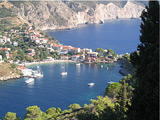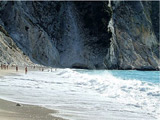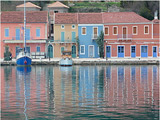The largest of the seven Ionian islands (700 sq km2 about). It's highest peak is Ancient Mount Aenos, 1628 m (5341feet) In Greece's west coast, Cephalonia has only 32,000 resident islanders. With Lefkas to the north and Zakynthos to the south the island is firmly on a tourist trail and grows each year as more accommodation becomes available and big tour operators move in. Despite the annual influx of visitors, mainly Italians, the island is so big it is still possible to get away to places where you are unlikely to meet a soul for days. Vast tracts of forest cloak the rugged limestone landscape, with ten peaks topping 5,000 feet.
According to the Greek mythology, the King of Cephalonia, Amphitryon, king of Thebes, was helped by the Athenian Kefalos, to oust the Native Taphians. In graditute, attacked Pterelaos. Amphitryon made a gift of the Island to Kefalos from whom it got its name.
It's archeological remnants refer to a civilization which developed thousand years ago. Archeological excavations have brought to light many Mycenean graves.
The history of Kefalonia is long and very interesting. The island was under the Turkish empire at the decade of 1460's and after under the Venetians and French. Finally England protected the island, until 1864 when all the Ionian islands joint the rest Greece.
In the catastrophic earthquake in 1953, sparing only a few spots in the north, entire town and villages where razed, more than 600 people died thousands where injured. Everything was rebuild since 70% of all constructions were demolished. At that time many desperate Cephalonians left their island to seek a better life abroad.
The capital and the main port of Cephalonia since 1757 is Argostoli, which is built on the inner coast of its peninsula. After the 1953 earthquake they were left very little remains; one or two houses, the arched bridge stretching across the lagoon and the obelisk at its center, which commemorates the date of its construction.
Argostoli is also the seat of the Greek Orthodox Church. The visitor to Cephalonia will be fascinated by the infinite variety of the natural surrounding, where sea, mountain, and small, green plains are harmonously combined together.
Kefalonia is an island as attractive to walkers as it is to sunbathers. For the walker there are acres of inland forest covered mountains to explore. For sun bathers there are plenty on beaches (many of them among the most beautiful in the Mediterranean. Is one of Greece's best secrets and once voted 10th in a world scenic beauty league, thus it demands and deserves exploration.
Beautiful golden beaches, lofty mountains providing the scenic backdrop to hundreds of secluded white coves , the strange cliffs , the cave of St. Gerassimos - the island's patron saint, the Cave of Drongorati, the underground lake at Mellisani, churches and Monasteries perched precariously on cliffs, timeless villages.
The limestone rock results in remarkable caves and caverns, some of which have become major tourist attractions. Geologists once grappled with the problem of the disappearing sea which flowed into swallow holes near Argostoli. No-one knew where it went until a couple of geologists tracked it with radioactive dye to the underground lake at Mellisani on the other side of the island. The coast is generally steep and sometimes precipitous as are the mountain roads that criss-cross the island.
The heavy winter rains make this one of the greenest and lushest of islands despite the rocky landscape and the Kefalonian fir is widespread. The many olive groves and vineyards (Kefalonia boasts some of the best wine in Greece) are testimony to the islanders' reliance on agriculture before the relatively recent arrival of the tourist.
From the traditional Fiskardo to the small tourist town of Poros, and the fascinating villages of Livatho which captivated Lord Byron with their beauty for four months, Cephalonia reveals to the visitor a glimpse of paradise at every turn.
On no other island can one encounter such fantastic natural phenomena as in Cephalonia, from the caves of Drogarati and Melissani to Katavothres (swallow-holes).
The imposing rock of Ainos stands over the Ionian Sea, offering a panoramic view over Cephalonia and the surrounding islands.
The "Great Mountain", called "Monte Nero" by the Venetians, with its unique fir-tree forest, offers the visitor a place of soul-uplifting serenity.Kephalonia has hundreds of picturesque villages and small towns, with an architecture and tradition all their own, surrounded by enchanting nature.
Beautiful houses, tiny villas, and gardens with countless flowers, creating a palette of colors and a captivating aroma. It is perhaps the most beautiful of all Greek villages.
Lastly, at the top of Ainos, live herds of the famous, exquisite wild horses of Cephalonia. This is ab enchanting sight, a pisture of strength and freedom, a picture of a rebellious pride which seems to be the very soul of the island... Villages Travelling south The monastery of Agios Gerasimos.
  
Click to enlarage |

